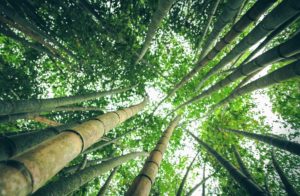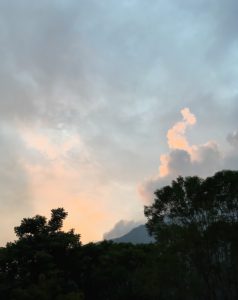Culturally, college teaching is highly esteemed in Chinese society. Financially, it does not provide the same kind of return. However, from time to time, dad’s professorship did come with some perks.
In 1949, Taiwan University was entrusted a large forest area, “The Experimental Forest,” in central Taiwan. It was designated mainly for researches in agriculture and forest management. Lodging was established near Xitou (溪頭, river headwater) Village in Natou (南投) County for students and faculty members, pursuing research projects in summer months. Chiang Kai-shek was said to have frequented the area for its natural beauty. Because dad was on the faculty, we were able to visit the forest and stay at the guesthouse.
Our first stop was at the township of Zhushan (竹山, bamboo mountain). It was the center of Taiwanese bamboo industry. Wide range of productions, from small items such as toothpicks, chopsticks, handcrafts and toys to large pieces of sculptures and furniture, were on display along the narrow streets. Some small decorative handcraft showed time-consuming details. The large items were solid yet elegant. There was a hint of fresh-cut-bamboo aroma in the air. We met the manager of the guesthouse before heading to Xitou.
Dense bamboo forests walled up the road leading to the mountain. From time to time scattering sunlight peered through the tall stalks with thick leaves.  Occasionally, where the soil was washed off by rain, one could see exposed roots and layers of decomposing leaves.
Occasionally, where the soil was washed off by rain, one could see exposed roots and layers of decomposing leaves.
Bamboo is held in high regard in Chines culture. Its stems have sections “有節”. The word “節” also means integrity. They are hollow “虛” inside, symbolizing modesty. They are tall and slim, elegant in appearance. Along with plum 梅, orchid 蘭, and chrysanthemums 菊, it is one of the “four gentlemen” in Chinese paintings (畫中四君子). Tolerant of bitter wind and icy weather, bamboo is one of “three friends of winter” (歲寒三友)—pine and plum being the other two. Like many who grew up under the influence of Confucianism, I felt a special attachment to it. Being surrounded by bamboo was extremely calming and meaningful.
Entering the premise of the Experimental Forest, there was a simple two-story building. On the first floor, there was an open space for gathering, also served as the restaurant. The set up was very simple. Not surprisingly, bamboo shoots—fresh and pickled—were the main ingredients of our dinner.
We stayed at a small cottage. . . very much like the ones in storybooks. The interior was also made up with mostly natural material. The atmosphere was cool and damp even in the middle of summer. Serenaded by insects, snuggling under the comforters, we fell asleep.
Next morning, we followed signs along the hiking paths to see a giant red cypress (Chamaecyparis formosensi). It was believed to be about 2000 years old. The moisture in the air dampened our clothing. Ferns, small and tall, cover the ground. Moses made the paths slippery at times. We had to walk carefully. We also visited another scenic spot, University Pond (大學池). Over the quiet pond, there was an arch bridge made of Moso bamboo. During one of his visits to the area, Chiang Kai-shek met and took a photograph with some students there.
Confucius said: “An intelligent person finds pleasure in water; a benevolent person finds pleasure in mountain. An intelligent person prefers to move; a benevolent person prefers to stay peacefully.” (子曰: 智者樂水, 仁者樂山. 智者動, 仁者靜.) I am not sure if I could consider myself a kind person. I do know that, as much as I like water, I always enjoy being near mountains. My childhood visit to Xitou remains my favorite traveling experience. The greenness and the profound peacefulness of the forests made permanent inscriptions within me.
Our next destination was Sun-moon Lake (日月潭). It was so named because one side of the lake shaped like the sun, and the other side like a crescent moon, separated by a small island (光華島). I have seen many photos of the lake, the island and the surrounding area. I always imagined kayaking on the lake—although I could barely swim. We hired a small boat for sightseeing and made a brief stop on the island. I was disappointed by the size of the island and by its appearance. Mom always said that everything looked better in a picture. In this case, it was very true. Perhaps my appreciation of the forest changed my perspective and made me expect something even more beautiful.
Since my sister-in-law grew up in Zhushan, every time we visited neighboring areas, we always stopped there for lunch, or at least a brief detour. Although the streets are still narrow, the bamboo industry no longer dominates the livelihood of the town. Productions of tea and fruits have taken prominence. A midway stop between Taichung city and nearby tourist spots, the traffic gets congested at times.
A few times we revisited Sun-Moon Lake. For several years, when tourists from China arriving in flocks, constructions of high-rise hotels took off. Small wooden boats were replaced by motor cruises. The crowd, the noise and the neon lights quickly changed the nature of the entire area. However, I must admit that it was very nice to look over the lake from the full-length windows of a newly designed hotel. Since 2016, due to policy conflicts between Beijing and Taipei governments, tourism in the area declined drastically. Revitalizing touristic traffic has become an urgent issue for the local leaders.
Shortly after our first trip to Xitou, it was opened to general visitors. Over the years, hotels, bed & breakfast, restaurants built up in the immediate vicinity. Traffic congestions were common scenes during weekends and holidays. The last time we were there, small hiking paths had turned into open promenades—no need to fear for slippery rocks. The cottage that used to be the Presidential summer house, still surrounded by dense bamboos, had been restored and updated. Mom, having recovered from her second knee replacement surgery, hiked with us all the way to the overlook. Many hikers chatted with her and cheered for her. Only when we started walking downhills, she realized that she might have pushed a bit too far. That was the last long walk that I took with mom.
In September 2016, the giant red cypress collapsed after heavy rain washed off the ground supporting its root system. Modern equipment provided precise measuring of its height, weight and AGE: 1810 years. Still, it had a long and memorable life.
I am forever grateful for having had the opportunities to travel with my family. These trips enriched my understanding of nature and of people.
To learn more about the symbolism of bamboo in Chinese culture:
Four gentlemen in paintings – Wikipedia
Three friends of winter – Wikipedia
To learn how the forests grow. To be surrounded by bamboos and greenery:
Xitou Nature Education Area: Official Site,
Travel in Taiwan – Xitou Nature Education Area,
Xitou Nature Education Area – Round Taiwan Round
Find out more about Sun Moon Lake:
Sun Moon Lake Scenic Area: Official Site

 Late August, traveling with my family. . .
Late August, traveling with my family. . . Decades later, staying at a bed and breakfast near Dajia River with all its amenities, I felt a deep sense of melancholy. There is a Chinese saying: 景物依舊, 人事全非 (The scenery is still as before, but people and conditions have all changed.) In this case, even the sceneries had changed a great deal. A 7.3 magnitude earthquake on September 21, 1999 not only destroyed multiple sections of the Cross-Island Highway but also reshaped central Taiwan geologically. Typhoon Mindulle ruined attempts to repair and reopen the roadway. Today, the section between Guguan and Lishan is indefinitely closed to regular traffic.
Decades later, staying at a bed and breakfast near Dajia River with all its amenities, I felt a deep sense of melancholy. There is a Chinese saying: 景物依舊, 人事全非 (The scenery is still as before, but people and conditions have all changed.) In this case, even the sceneries had changed a great deal. A 7.3 magnitude earthquake on September 21, 1999 not only destroyed multiple sections of the Cross-Island Highway but also reshaped central Taiwan geologically. Typhoon Mindulle ruined attempts to repair and reopen the roadway. Today, the section between Guguan and Lishan is indefinitely closed to regular traffic.